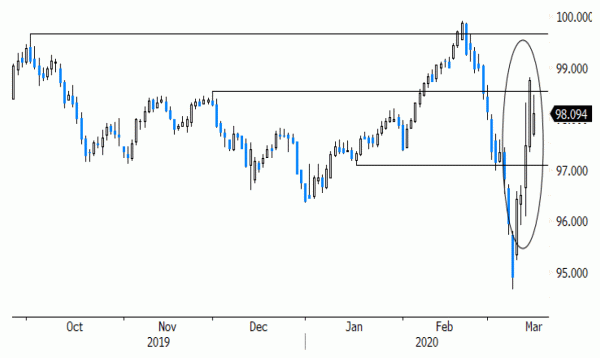- Rates: Fed fires bazooka
The US central bank went all in at yesterday’s second emergency meeting of the month. They used all policy tools available to shield the US economy from a sharp hit from the coronacrisis. US yields plunge by 20 bps to 30 bps across the curve. Stock markets sell off, suggesting little confidence in what maxed out policy can do. - Currencies: Dollar retains benefit of the doubt as hunt for liquid assets dominates
The aggressive easing of the Fed and the provision of USD liquidity outside the US are in theory a USD negative. Investors probably will be cautious to reduce USD holdings as long as global markets stress remains as high as it is now. EUR/GBP rebounded north of the 0.90 barrier.
The Sunrise Headlines
- US stocks soared on Friday with gains up to 9.36% (DJI), clawing back from their freefall as authorities ramped up their response to the coronacrisis. Asian markets plunge despite coordinated CB action. Australia underperforms (-9.7%).
- The Fed slashed its policy rate by 1% to 0%-0.25%, launched a massive $700 bn QE programme and re-installed USD swap lines with other major CBs as part of its sweeping measures to shelter the economy from the coronaciris-blow.
- NY – the US’ financial and cultural capital – declared a state of emergency after the coronavirus claimed its first victims. The mayor ordered public schools, museums, restaurant, etc. to shut down and hinted a possible lockdown.
- The shutdown of Europe expanded drastically as more European countries shuttered businesses, chased people into their homes and turned to border closures in a race to contain the growing threat of coronavirus pandemic.
- The Chinese economy suffered a heavier blow than analysts feared from the corona pandemic as industrial output plunged 13.5% (Y/Y), retail sales tumbled 20.5% and fixed-asset investment slumped 24.5% in January and February.
- The BoJ is ramping up its ETF purchases (doubling the target to ¥12 tn) and set up a new 1-year lending facility under which banks borrow at 0% to boost credit extension to businesses to combat the economic shock of the coronacrisis.
- Today’s economic calendar eyes meagre. The Empire Manufacturing is due in the US but will be of little importance as corona dominates. Euro-area finance ministers meet today to discuss an action plan to combat the coronacrisis
Currencies: Dollar Retains Benefit Of The Doubt As Hunt For Liquid Assets Dominates
Dollar holding relatively strong despite Fed action
Global markets staged an (interim) countermove on the recent sell-off on Friday. Core yields and equities jumped higher. The driver behind the move was vague. The spike of US equities at the end of the day suggests a technical short squeeze ahead of the weekend. The USD outperformed the other majors. USD/JPY was squeeze higher to close at 107.62. The dollar also rebounded back to the EUR/USD 1.1060 area against the single currency. USD strength prevailed, but the disperse communication from the ECB and the fragmented approach within the E(M)U were also no help for the euro.
This weekend, governments and central banks took unprecedented steps to address the corona crisis. The Fed brought its policy rate close to zero and took big measures to provide ample liquidity and sustain the flow of credit to the economy. The reaction of the dollar to the extreme Fed measures is moderate. It is not easy for markets to assess the relative significance of the measures taken by authorities across the world and translate them into the FX market. USD/JPY (106.50 area) is trading with a negative bias. The BoJ stepping up asset purchases for now apparently is seen secondary to the Fed actions. EUR/USD jumped to the high 1.11 area after the Fed decision, but soon returned to the lower part of the 1.11 big figure. The yuan traded rather stable around USD/CNY 7 even as Chinese eco data showed devastating impact of the virus on February economic activity.
Today, the flood of measures from governments and central bankers is likely to continue. The aggressive Fed easing and the availability of ample USD liquidity via swaps in theory is a USD negative and should help to address USD shortages. However, the price moves last week showed that the dollar is still preferred in times of extreme stress. It is still highly uncertain whether USD liquidity will float to all parts of the credit markets that will need it. In this context, we expect the dollar to hold rather strong. It will likely take longer for investors to reduce USD holdings in line with the relative monetary policy stance until the level of global markets stress eases. At end of last week, the technical picture of EUR/USD became again more neutral as the pair looked for a new ‘equilibrium’ in the 1.1050/1.1250 trading range.
At the end of last week, sterling remained in the defensive, despite the rebound on other markets, suffering from the hunt for liquid assets. We don’t expect that to change anytime soon.
USD trade weighted (DXY) dollar holding relatively strong despite aggressive fed easing/liquidity injection













